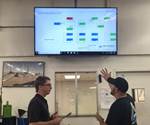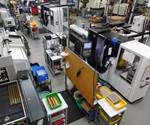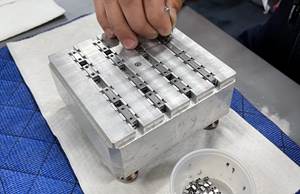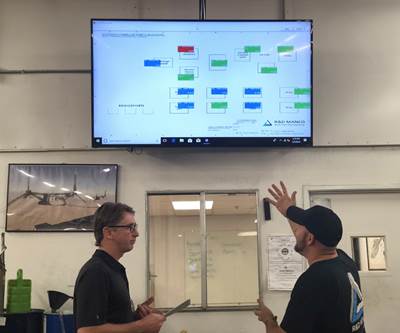Practical Approaches to Automation
Automation isn't just useful for large volumes of the same part. Today, it is increasingly being used in machine shops for high-mix, low-volume jobs.
The video above is just part of the content you will find in the IMTS spark Knowledge Center “Practical Approaches to Automation.” This Knowledge Center provides a single, deep-dive format that’s easy to follow, easy to share and fun to explore as it covers automation concepts you need to understand for your manufacturing business. Topics covered include:
- The case for automation
- Levels of automation
- An automation roadmap
- Stabilizing and standardizing processes
- Lights-out machining
- The human factor
Be sure to explore the Practical Approaches Knowledge Center on IMTS spark today.
Here is the transcript from the video above:
Emily Probst, Modern Machine Shop
Hi, I'm Emily Probst, senior editor with Modern Machine Shop, and I'm here with Pete Zelinski, editor-in-chief of Modern Machine Shop. Pete, today I brought you here to talk about automation.
Peter Zelinski, Modern Machine Shop
Right, automation. So that word covers a lot, but if there is a theme or an idea that is the most important for manufacturers, for machine shops, for what we write about in Modern Machine Shop — it's automation.
Emily Probst
So, when I think about automation, I often think of automotive applications in which a lot of the same part is made over and over. But automation doesn't have to be that way. In fact, automation is becoming more and more common in machine shops for high-mix, low-volume work. Pete, can you tell me about automation being used in machine shops? Can you make the case for automation?
Peter Zelinski
Okay, what do we mean by automation? So, “robot” is the first picture that comes to mind, but it means more than that. Automation could be machines that are able to do more in one setup, one handling. It also refers to other options like pallet systems for moving work around, in and out of machines. It refers to software that can automate certain operations. But I think the applicability of automation is changing, as you say, it's becoming more of an option for smaller facilities and smaller batches. But you asked about the case for automation, and I think the starting point there is what the case is not: Automation is not a replacement or an alternative for people.
The case for automation really has more to do with augmenting, expanding and amplifying what those high-value people can do.
The reason I say that is because the people in manufacturing who are apt to be most difficult to find are the high-skill, high-knowledge manufacturing employees, and really, automation can't take the place of what they do. There's no way to automate the kind of value they bring to the process. The case for automation really has more to do with augmenting, expanding and amplifying what those high-value people can do. So, find every repetitive task that people like that might do and find ways to automate them to set these people free for the higher-value work, of which there's plenty to do. Then there's also a broader possibility of extending the work of the whole facility as well by allowing production to continue into nighttime hours where otherwise that capacity is going unused, because all of the people have gone home. I think as we talk about this, we'll have to get into that — get into unattended machining. But I think there’s a more basic starting point: There are different levels of automation technology. Can you speak to that?
Emily Probst
So yeah, different levels of automation. The key with automation is to start small. I think a lot of shops get cold feet when they start thinking of automation. They think, “Oh my goodness, I have got to get a systems integrator. I've got to get a specialized person on the shop floor. I've got to think of this big, complicated nightmare, and I've got to get it solved right now.” But that's not the case. Machine shops can start small with automation, and one of the ways to do that is to, for example, start with quick-change workholding. And from there, maybe they bump into using a robotic loader and pallet pool and then they can do offline setup. From there they can jump into integrated robotic systems. The key is to start small and then set it up, step by step by step. That's a roadmap, if you will.
Peter Zelinski
Roadmap is the right word for it. It is possible to start very small and very basic with automation. In fact, I think the most important innovations in automation technology right now are at the low end — the basic end. Cobots are maybe the most obvious example of that. Collaborative automation makes it relatively simple to automate an existing machine and existing process, maybe even a machine that’s considered to be one of the lower-value pieces of equipment in the facility. The potential advantage and starting point that brings is the chance for shops to establish the rhythm for automation, see its benefits, begin to see their other potential wins for automation in the facility in the process, and begin to expand the use of automation out from there. There are technologies and techniques in parallel that can help facilitate and guide that advance of automation. One of these is just a culture of systemization and continuous improvement, which some manufacturers really have to a high degree. The habit of defining and systemizing every operation in the facility makes it that much easier to see exactly how to plug in automation and what steps it should do.
Similarly, machine monitoring is a very important, valuable technology. Monitoring plant-wide, how all of the machines are performing for a holistic view of all that performance together, because a machine-monitoring system can expose where there are gaps of downtime, maybe inevitable downtime, because someone had to walk away for something else that had to be done. Are these gaps that could be bridged with automation? But I think the important thing in all of this is the advance I’m describing, the journey I’m describing. We've associated automation with big plants, big factories for a long time, but that journey now is accessible to job shops.
Emily Probst
As a practical matter, it just doesn't seem to work for automation to be used in job shops, right? High-mix, low-volume — this doesn't seem to work. Then you’re left with the question of “how do you take a highly unstandardized process and make it something that’s standardized?” The way to do that is to come up with a common thread. Now, oftentimes this common thread is workholding. Take, for example, a shop that has a lot of different-sized parts, but these parts can all fit in a standard-size vice. In that situation, the robot can then grip the vise — not the part, but the vise — and load the machine from there. And in a way, it’s automation trickery. From the robot’s perspective, the robot is loading the same thing over and over. Another common thread would be finding the part families. Finding the same size, same shape of part and coming up with these part families that you could then run on a complex machining cell. Now, a job shop is going to cringe at that thought: “Why would I use a complex machining cell for fairly uncomplicated parts?” But the answer to that is you want to use your skilled machinist to run a standalone machine for these complicated parts. And by having that happen, your unattended machining grows. As that grows, as your shop becomes more comfortable with it, maybe that’s the case for lights-out machining.
Peter Zelinski
Yeah, that's a great picture that you paint there. There’s maybe an argument for sophisticated equipment doing simple work so that sophisticated employees can do the more complicated, the higher-touch manufacturing. There is a transition from there into lights-out, and I think that might be the biggest idea, the most important promise, in automation right now for American manufacturers. In many facilities, there is this untapped resource in the form of equipment that is not being used, sitting idle during the nighttime hours. It is not necessary to send work far away in search of lower-cost production, because a whole lot of facilities have the equivalent of this low-cost manufacturing partner that’s in the same building, just hours of the day. And so, the path toward that is automation that becomes so trusted, proven and reliable and works so well and so frequently within the daytime hours, but the natural extension of that is to allow it to just continue after hours and keep on producing into the night.
In many facilities, there is this untapped resource in the form of equipment that is not being used, sitting idle during the nighttime hours.
We’re already seeing this to some extent, but I think what’s increasingly going to be the case in machining in North America, is that facilities are going to divide the work they get into: here is the kind of repetitive, very automatable work that I do at night; here is the more challenging work that I need my skilled employees to work on during the daytime hours. Again, with those employees augmented, amplified and supported by automation, even during the day. So really, it’s an even bigger-scale way to amplify the work of these skilled people, because it is their knowledge that ultimately allowed these automated systems to be established — proven out to such an extent that those systems could keep on running when the people go home for the night. That sort of brings it back around to the human element in this and I wonder, could you talk about that human factor in automation?
Emily Probst
So the human factor in automation, man that’s a hot topic right there. We’ve got one school of thought that says automation is taking jobs, and then you’ve got the other school of thought that says, “actually, it is encouraging people to come work for my company, and it is keeping them there longer,” and regardless of your school of thought, automation is transforming human jobs — oftentimes for the better.
Regardless of your school of thought, automation is transforming human jobs — oftentimes for the better.
So, for example, say that there is a job that every person on the shop floor hates doing. Maybe that’s a good one to eye for automation. Or there’s the common example of the repetitive tasks, the tasks that hurt your machine operators. Those are all good examples for automation. The key is you want to use your humans for challenging jobs, you want to use their mind, you want them thinking “How can I improve this task? How can I benefit my machine shop? How can I think through this problem and make things better?” By challenging your employees in that way, you mentally stimulate them, and a challenged employee is one who will stay.
Peter Zelinski
Yeah, so that’s what we're really talking about when we talk about automation: We’re talking in large part about keeping people productive, as you said, keeping people engaged.
Emily Probst
Alright so let’s wrap this up. Automation: It’s not as big and complicated as you might think. It’s actually good for job shops with high-mix, low-volumes if you start small and build out from there. While you’re doing so, make sure to keep people at the heart of your process. I'm Emily Probst.
Peter Zelinski
I’m Pete Zelinski.
Emily Probst
Thanks for watching.
Related Content
Modern Bar Feeds Bring New Life to Automatic Swiss Lathes
Cam-actuated Swiss lathes are still the fastest way to process many parts. By adding modern bar feeders, this shop has dramatically improved their utilization with the ability to work unattended, even in a lights-out environment.
Read More4 Steps to a Cobot Culture: How Thyssenkrupp Bilstein Has Answered Staffing Shortages With Economical Automation
Safe, economical automation using collaborative robots can transform a manufacturing facility and overcome staffing shortfalls, but it takes additional investment and a systemized approach to automation in order to realize this change.
Read MoreNiche Work If You Can Get It: A CNC Machine Shop Crafts Its Own Destiny
The latest innovations in metalworking aren’t always related to CNC automation or robotics. For Rosenberger North America, a 2022 Top Shops Honoree, it is the company’s niche processes that create the biggest successes.
Read MorePartial Automation Inspires Full Cobot Overhaul
Targeting two-to-four hours of nightly automation enables high-mix manufacturer Wagner Machine to radically boost its productivity past a single shift.
Read MoreRead Next
Merging Advances: Lights-Out Machining Combines Automation and Focused Process Improvement
One of the most significant developments in machining right now is easy to miss because it is the union of two different advances coming together.
Read MoreSmall Shop Sees Big Gains from Right-Sized Automation
A three-person German machine shop applies quick-change workholding and flexible robotic automation to succeed in a high-mix/low-volume production environment.
Read MoreRunning Unattended at Night Lets Machine Shop Serve New Customers During Day
Precision Tool Technologies found capacity for diversification not by adding machines, people or space, but by freeing up time. Running unattended—running so it can machine through all 168 hours in the week—has enabled this shop to use hours when staff is present to deliver work that lands outside its established specialty. To achieve unattended machining, some of the biggest challenges have related to basic details such as chips and coolant.
Read More


.JPG;maxWidth=150;quality=70)















.png;maxWidth=300;quality=90)









.JPG;maxWidth=400;quality=70)

